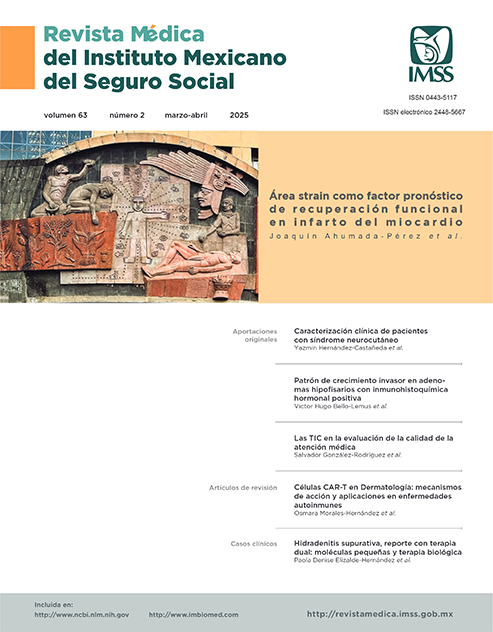Clinical characterization in patients with neurocutaneous syndrome
Main Article Content
Keywords
Neurocutaneous Syndromes, Neurofibromatoses, Cafe-au-Lait Spots
Abstract
Background: Neurocutaneous syndromes are a group of genetic diseases that affect the skin, eyes, central and peripheral nervous systems. They include Neurofibromatosis type 1 (NF1), Tuberous sclerosis (TS), Von-Hippel Lindau disease, Neurofibromatosis type 2 (NF2), Ataxia Telangiectasia (AT) and Hypomelanosis of Ito.
Objective: To characterize the most frequent clinical manifestations in Neurocutaneous syndromes.
Material and methods: A descriptive, observational, cross-sectional and ambivalent study was carried out in the Genetics service of the General Hospital of Zone No. 20. Patients diagnosed with any neurocutaneous syndrome of any age were included and agreed to participate in the study.
Results: Thirty-nine patients were reviewed, 21 patients (53.8%) were women and 18 (46.2%) were men. The median age of the patients was 12 years, with an interquartile range (25th-75th percentiles) of 6 and 17 years, respectively. The most frequent neurocutaneous syndromes were NF1 (62%) and ET (18%). All patients presented cutaneous manifestations, and 16 patients (42.1%) presented at least one neurological manifestation.
Conclusions: The timely interpretation of skin changes as primary lesions becomes a valuable instrument for the early identification of any neurological alteration; likewise, the search for skin changes should be carried out in all patients undergoing initial study for neurological manifestations.
References
Ruggieri M, Gentile AE, Ferrara V, et al. Neurocutaneous syndromes in art and antiquities. Am J Med Genet C Semin Med Genet. 2021; 187(2):224-234. doi: 10.1002/ajmg.c.31917.
Iyer RR, Strahle JM, Groves ML. Neurosurgical Considerations of Neurocutaneous Syndromes. Neurosurg Clin N Am. 2022; 33(1):81-9. doi: 10.1016/j.nec.2021.09.013.
Silva YB, Gil M, Chaviano-de León M, et al. Síndromes neurocutáneos y leucemia linfoide aguda: a propósito de un caso. Rev Cuba Hematol Inmunol Hemoter. 2021;37(1):1-7. Disponible en: https://revhematologia.sld.cu/index.php/hih/article/view/1156
Tolliver S, Smith ZI, Silverberg N. The genetics and diagnosis of pediatric Neurocutaneous disorders: Neurofibromatosis and tuberous sclerosis complex. Clin Dermatol. 2022;40(4):374- 382. doi: 10.1016/j.clindermatol.2022.02.010
Barros FS, Marussi VHR, Amaral LLF, et al. The Rare Neurocutaneous Disorders: Update on Clinical, Molecular, and Neuroimaging Features. Top Magn Reson Imaging. 2018;27(6):433-62. Disponible en: https://pubmed.ncbi.nlm.nih.gov/30516694/#:~:text=doi%3A%2010.1097/RMR.0000000000000185.
Gómez MT, Vargas JA. Esclerosis tuberosa. Rev Méd Sinerg (San José En línea). 2019;4(3):21-37. doi: 10.31434/rms. v4i3.182.
Salussolia CL, Klonowska K, Kwiatkowski DJ, et al. Genetic Etiologies, Diagnosis, and Treatment of Tuberous Sclerosis Complex. Annu Rev Genomics Human Genet. 2019; 20:217- 240. doi: 10.1146/annurev-genom-083118-015354.
Cascarino M, Leclerc-Mercier S. Histological Patterns of Skin Lesions in Tuberous Sclerosis Complex: A Panorama. Dermatopathology (Basel). 2021;8(3):236-252. doi: 10.3390/ dermatopathology8030029.
Koster R, Brandão RD, Tserpeli D, et al. Pathogenic neurofibromatosis type 1 (NF1) RNA splicing resolved by targeted RNAseq. NPJ Genom Med. 2021; 6(1):95-104. doi: 10.1038/ s41525-021-00258-w
Wang W, Wei CJ, Cui XW et al. Impacts of NF1 Gene Mutations and Genetic Modifiers in Neurofibromatosis Type 1. Front Neurol. 2021;12:1-12. doi: 10.3389/fneur.2021.704639
Napolitano F, Dell’Aquila M, Terracciano C, et al. Genotype-Phenotype Correlations in Neurofibromatosis Type 1: Identification of Novel and Recurrent NF1 Gene Variants and Correlations with Neurocognitive Phenotype. Genes (Basel). 2022;13 (7):1130. doi: 10.3390/genes13071130
Tiwari R, Singh AK. Neurofibromatosis Type 2 Treasure Island (FL): StatPearls Publishing; 2020. Disponible en: https://www. ncbi.nlm.nih.gov/books/NBK470350/
Bachir S, Shah S, Shapiro S, et al. Neurofibromatosis Type 2 (NF2) and the Implications for Vestibular Schwannoma and Meningioma Pathogenesis. Int J Mol Sci. 2021;22(2):690. doi: 10.3390/ijms22020690.
Tamura R. Current Understanding of Neurofibromatosis Type 1, 2, and Schwannomatosis. Int J Mol Sci. 2021;22(11):5850. doi: 10.3390/ijms22115850
Coy S, Rashid R, Stemmer-Rachamimov A, et al. An update on the CNS manifestations of neurofibromatosis type 2. Acta Neuropathol. 2019;139(4):643-65. doi:10.1007/s00401 -019-02029-5
Riboldi GM, Samanta D, Frucht S. Ataxia Telangiectasia [Internet]. PubMed. Treasure Island (FL): StatPearls Publishing; 2020. Disponible en: https://www.ncbi.nlm.nih.gov/books/ NBK519542/
Martínez-Córdoba N, Espinosa-García E, Martínez-Córdoba N. Ataxia telangiectasia: a diagnostic challenge. case report. Case reports. 202 6(2):109-17. Disponible en: doi:10.15446/ cr. v6n2.83219
Amirifar P, Ranjouri MR, Lavin M, et al. Ataxia-telangiectasia: epidemiology, pathogenesis, clinical phenotype, diagnosis, prognosis and management. Expert Review of Clinical Immunology. 2020 Oct 15;1-13. doi: 10.1080/1744666X.2020.1810570
Arora V, Tandon R, Dua-Puri R et al. Hypomelanosis of Ito. Indian Journal of Pediatrics. 2022 Jun 22; 89(11):1117-9. doi: 10.1007/s12098-022-04208-x
Zamudio-Martínez G, Zamudio-Martínez A, Hernández-Arriaga P, et al. Mosaicismo pigmentario del tipo hipomelanosis de Ito con hemimegalencefalia. Acta Pediatr Mex. 2019;40(4):217- 222. doi: 10.18233/APM40No4pp217-2221853
Taccone M, Rutka, J. Neurocutaneous Syndromes. Oncology of CNS Tumors, 389-424. doi: 10.1007/978-3-030-04152-6_19
Kaur S, Kaur S, Goraya J. Spectrum of Neurocutaneous Syndromes in Children in Neurology Practice. Journal of Pediatric Neurology. 2017 Aug 24;16(04):217-21. doi: 10.1055/ s-0037-1606335
Nino K, Gutmann DH. The management of neurofibromatosis type 1 (NF1) in children and adolescents. Expert Review of Neurotherapeutics. 2024 Feb 27;24(4):409-20. doi: 10.1080/ 14737175.2024.2324117
Oshi MAM, Alrhman AA, Mardi TG. Clinical Presentations and Pattern of Neurocutaneous Syndromes among Sudanese Children Attending Outpatient Clinic of Soba University Hospital, 2015. International Journal of Medical Research & Health Sciences. 2018;227(5):128-35.
Sánchez-Marco SB, López-Pisón J, et al. Neurological manifestations of neurofibromatosis type 1: our experience. Neurología (English Edition). 2021. doi: 10.1016/j.nrleng.2019.05.008.
Rubilar C, López F, Troncoso M, et al. Estudio clínico genético en pacientes con complejo de esclerosis tuberosa. Revista chilena de pediatría. 2017;88(1):41-9. doi: 10.51581/rccm. v24i1.346
Kampitsi CE, Nordgren A, Mogensen H, et al. Neurocutaneous Syndromes, Perinatal Factors, and the Risk of Childhood Cancer in Sweden. JAMA Netw Open. 2023;6(7):e2325482. doi: 10.1001/jamanetworkopen.2023.25482


